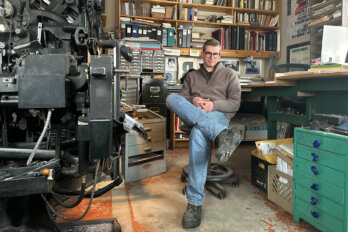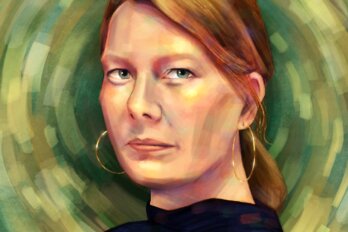The final scene of Robert Flaherty’s 1922 silent film, Nanook of the North, is a sweet domestic montage. The little family of the Inuit hunter Nanook is tucking in for the night, inside an igloo , a house cut from blocks of snow that, as the on screen script has told us, Nanook can build in less than one hour. Previously, we have seen Nanook do this — neatly, swiftly carving pieces of perfect snow into large blocks, stacking, fitting, smoothing them with a blade cut from a walrus tusk, and then cutting a block of sheer ice and mounting it into the house as a window. Then we see Nanook’s beautiful wife Nyla polishing the inside of the window.
But now it is night. Everyone is snuggling down into a bed of skins and furs. The sled dogs are huddled outside, still in their traces, their puppies secured inside the igloo. The members of the family have removed their sealskin boots; Nanook, his back to the camera, gets naked to the waist in the middle of the bed. There are several small children with black tousled heads cuddled up to the adults. The two wives, Nyla and Cunayou, in the tradition of ethnographic photography, face the camera while removing their sealskins and fur parkas, so that we may briefly enjoy the sight of their breasts.
The dogs howl and shiver, their fur thickened by snow as the blizzard rages. Flaherty cuts for several minutes between closeups of the dogs, wide shots of the landscape being battered by wind and snow, and closeups of the sleeping family. The final shot is one of Nanook’s robust, smiling face, sound asleep. Tia Mak: The End.
The end, in a real sense, came too soon for Allakariallak, the Inuk hunter who played Flaherty’s hero, Nanook. For although Nanook is hailed as a documentary for its close observations of a way of life, it is in most respects a fiction about a way of life already past. Its mythical characters are played by local Inuit of the community of Inukjuak on the eastern coast of Hudson Bay (Quebec and, by 2009, the territory of Nunavik). In 1923, one year after Nanook was released, Allakariallak starved while hunting on the tundra, built a snow house, and crawled inside to die.
It was the end for Flaherty himself in the Arctic, too; he went back to New York, cut the film with his wife Frances, sold the distribution rights to Pathé, made his name, fame, and fortune, and never went north again. Nanook of the North was an unprecedented commercial success worldwide. Allakariallak’s face graced ice cream packaging, and the name Nanook came to mean “strong man” in Malaysia. Filmmakers like Orson Welles and Sergei Eisenstein called Nanook of the North a masterpiece. Flaherty’s subsequent career was haunted by the success of Nanook; he was apparently a difficult individual, not a great collaborator, and films like Moana and Louisiana Story, while well received, never achieved the status of Nanook. Flaherty died at age sixty-seven in 1951. John Grierson of Canada’s National Film Board, his friend and colleague, wrote a memorial essay and found in Flaherty’s heroes from Nanook onward an eager, hopeful boyishness embodying “the son he never had.”
But it was not the end of Flaherty in the Arctic; look again at Nanook’s sweet sleeping family, at the radiant wife Nyla, played by a young Ungava Inuk named Maggie Nujuarluktuk. She was five months pregnant when Robert Flaherty left Inukjuak with his footage, and on Christmas Day, 1921, she gave birth to his son, Josephie Flaherty, a residual of Flaherty’s triumphant Arctic sojourn never acknowledged in his lifetime.
Flaherty’s “fearless, lovable, happy-golucky Eskimo” family became iconic. Nanook of the North portrays the Inuit as resourceful, successful hunters in a sublimely hostile landscape where other humans would perish. The film celebrates the closeness of the family, the easy affection and humour of men and women, their love of children, the collaborative nature of the enterprise of survival. But the ironies in both the film’s making and its lingering impact are legion.
In order to tell his story of the intrepid hunter and his family, Flaherty removed all but the slightest references to their connections with the white world, keeping only those that were humorous — an Inuk infant enjoying a spoonful of castor oil — or emblematic of quaintness — a scene showing Nanook listening with hilarity and incredulity to a windup gramophone and then trying to eat the record. The Inuit, many of whom smoked constantly, were forbidden to smoke on film. They were not allowed to use guns as they would have done to kill walrus; here is Flaherty describing the making of the walrus-hunt sequence:
“Nanook picked out the biggest bull, rose quickly and with all his strength landed his harpoon. The wounded bull, bellowing in rage, his enormous bulk diving and thrashing the sea (he weighed more than 2,000 pounds), the yells of the men straining for their lives in their attempt to hold him, the battle cry of the herd that hovered near. . . . [It] was the greatest fight I have ever seen. For a long time it was nip and tuck — repeatedly the crew called to me to use the gun — but the camera crank was my only interest then and I pretended not to understand. . . . For at least twenty minutes that tug o’war kept on. I say twenty minutes advisedly for I ground out 1,200 feet of film.”
And the practicalities of shooting film in an Arctic winter and processing it daily (the beginning of the tradition of rushes) would have been impossible without the Inuit cast and crew. As Frances Flaherty recalled in a 1960 article:
He had the Eskimos to help him — Nanook and three others: Wetaltook, Tookalook, and Little Tommy. They did everything for him. They brought water for developing the film, chiseling six feet down through river ice and bringing it in barrels sloshing with ice and deer hair that fell into it from their fur clothing. They strained it and heated it. They built a drying reel out of driftwood, combing the coastline for miles to pick up enough wood to finish it. When Bob’s little electric light plant failed to give a light steady enough for printing, they blacked out a window all but a bit the size of a single motion-picture frame, and through this slot Bob printed his film, frame by frame, by the light of the low arctic sun.
Reality never impinges on Flaherty’s Nanook; his “kindly, brave, simple Eskimo” is a man in perfect harmony with his world. We see warm shining faces framed by luxuriant fur, deep clear pools of water from which fat fish leap. Much silent laughter. We can only imagine the mournful yowling of the dogs and the incessant hammering of one of the coldest winds on Earth.
By the early 1950s, Robert Flaherty’s son Josephie and the community of Inukjuak in which he lived were utterly dependent upon the qalunaat, the white man. Instead of hunting for food, the Inuit mostly hunted for white fox and were paid in Hudson’s Bay store credits. Their settlements were no longer nomadic and farflung, but close to white communities, which by this time consisted of fur traders and factories, an rcmp constable, a nurse, a teacher, and staff for the joint US/Canada meteorological and radiosonde stations; Josephie was the chore boy for the radiosonde station. Missionaries and priests and senior bureaucrats came through regularly on the supply ship C. D. Howe. This proximity brought changes in living habits and diet, greater exposure to diseases like polio and tuberculosis, and a reliance on welfare in years when the price for furs was low or food sources were threatened. The Inuit had fallen under the purview of the Department of Northern Affairs and National Resources. They were known individually only by numbers until 1960 (Josephie was simply e9701) and were referred to collectively as the Eskimo Problem.
In 1953, the Department of Northern Affairs decided to relocate seven Inukjuamiut families from Inukjuak to the High Arctic; the stated rationale was to alleviate the pressures of dependency. There was a history of shuttling the Inuit around in their forbidding landscape, but underlying this essentially bureaucratic response to what were, in many cases, terrible conditions was an ingrained racism. The Inuit (the meaning of the word is simply “the people”) were not treated as people. They were a problem for which there had to be a solution. In this case, the welfare solution (returning Nanook to his real North) happened to coincide with larger strategic considerations (politicians wanted a Canadian presence in the High Arctic).
The Inuit were not consulted. Thirty-three people (chosen or who “volunteered”) were loaded onto the C. D. Howe with their motley possessions, including sled dogs not bred for the region and kayaks too flimsy for the heavier northern ice. Many of the promised and essential supplies and provisions never arrived at either Resolute Bay or Grise Fiord, where the families, arbitrarily divided, ended up. The Inuit were seen as returning to their traditional way of life but made to live in campsites chosen by their white overseers, close — but not too close — to an rcmp detachment. They were to hunt and fish in the traditional ways, except that there were rules and penalties: no muskox could be hunted at all, and the constable decided how many caribou could be shot.
From the government’s perspective, this exercise was merely a relocation — logistics to be dealt with as they arose — and for the most part, damn successful. For the Inuit, this was a cruel exile from their families and their homeland, banishment to a foreign, dark land — dark meaning a place where the sun never rises for the four coldest months of the year. Even those white men with long experience in the Arctic and a genuine if paternalistic affection for the Inuit did not grasp, apparently, that a move from Ungava to Ellesmere Island was like a move from Toronto to Timbuktu.
Melanie McGrath’s book The Long Exile is a compassionate, absorbing account of this exercise from the Inuit perspective. This British journalist spent time, in spring and summer, in both the Barrens and the High Arctic communities of Resolute and Grise Fiord. She took considerable effort to understand the subtleties of the Arctic seasons and landscapes, to hear the lament of the softspoken Inuit and to imagine — in detail worthy of Flaherty — their fear, their despair, and the shock of being deposited in a vast, vacant place (empty, because unknown) and being expected to just start hunting.
The intentions of the Department may have been honourable, but the relocation was surely a travesty in its execution, mostly by rcmp constables — a travesty of ignorance, indifference, and deceit. It was meant to be a volunteer process; it was at best a profound cultural misunderstanding. At worst? More of a cull, a coercion of language and power.
Canadians did hear relocation stories, from the 1950s in the passionate, enraged books of Farley Mowat, and then in a more cautious forum, the Royal Commission on Aboriginal Peoples in the early 1990s. The Commission concluded in 1994 that the relocation was not done because limited game resources were causing dependency but, put bluntly:
“The concern was with the ability of the fur trade to sustain the income levels to which the Inukjuak Inuit had become accustomed. . . . It was recognized in the Department that the cyclical nature of hunting could and did lead to periodic famine and starvation. This was considered to be the natural state for the Inuit. The goal of the relocation was to restore the Inuit to what was considered to be their proper state. . . . Moreover, many Inuit were kept in the High Arctic for many years against their will when the government refused to respond to their requests to return.”
The distinguished civil servant Gordon Robertson told the commission that it was “a travesty of justice to have [the civil servants’] motives misinterpreted, to have them held up to ridicule.” To read the summaries of the testimonies of officials and those who were relocated before the Commissioners is to read irreconcilable narratives from different galaxies. McGrath’s book, while occasionally overblown in its digressions and imagined journey into the Inuit life and psyche, makes of this complicated tale of hunters and bureaucrats a rich drama. She finds, in the Inuit telling of their story before the Commission, “nothing short of the rebirth of a people. . . . They had given the Arctic back its authentic voice.”
Josephie Flaherty and his family went to Grise Fiord in 1955 to join other members of his family. Once they were on the C. D. Howe, their two-year-old, Mary, was diagnosed with TB and sent south to a sanatorium. She came back to them, in Grise Fiord, three years later with no idea who her real family was, having been carelessly dumped for a year at a time at both Inukjuak and Resolute because no one bothered to find out where her parents actually were. Josephie’s son Peter was mentally impaired, his mother, Rynee, believes from starvation. Josephie became a despondent, violent man, and had a mental breakdown in 1968 from which he never recovered. He died in 1984 from lung cancer. He was one of the many who longed until his death to return home.
The Inuit called the C. D. Howe “the place where you take your clothes off” because they did, with dread, for annual medical examinations. It was not only the ship of inspection but the ship that carried people away, mostly children, to the tuberculosis sanatorium in The Pas, Manitoba. On occasion, it also unwittingly carried tuberculosis, flu, polio, and typhoid to Arctic ports where supplies were dropped off. Northern bureaucrats called the C. D. Howe the Shakespeare ship: TB or not TB.
Early in Kevin Patterson’s brilliant novel, Consumption, we find ourselves aboard the Shakespeare ship in 1962 with a consumptive Inuk girl named Victoria being carried south from Rankin Inlet, on the west side of Hudson Bay, to The Pas, where she lives for six years and is returned to her family, her Inuktitut awkward, her trauma of exile unacknowledged. Patterson, who has worked as a physician in the Arctic, has built a compelling fiction out of his own experiences. Tuberculosis used to be called consumption, but this novel is also about addiction, anorexia, and the merciless erosion of Inuit traditions by white interlopers, including Victoria’s laconic husband Robertson, a man seduced by diamonds, and an American doctor, Balthazar, who has good intentions with disastrous results. It is too late for a white artist to romanticize the Inuit; Patterson writes from a position of prolonged engagement as a clinician. But, like Flaherty and McGrath, he seeks a paradigm of nobility, a way of honouring the Inuit, setting them outside the grim realities of this modern, tainted life:
What the Inuit were was a miracle. They lived in a land without trees, in houses made of snow. When there was no driftwood to be had, they made sled runners out of frozen fish wrapped together. Their technologies — the qayak and the toggle-headed harpoon and the seal-fat lamps — were the most elegant solutions to the problems of living in this land, and the finest expression of their wit and sense of beauty. What the Inuit are is us. And what they achieved in the Arctic was the clearest expression of human ingenuity and tenacity. They — we — prospered in the hardest place there is, and achieved magnificence.
But no one lives there anymore.
To southern Canadians, the story of the High Arctic exiles may read like history, a terrible story indeed, but the wounds have surely closed by now. Some Inuit returned to Inuk-juak, but many stayed in the High Arctic. Resolute and Grise Fiord have survived their worst years. There has been compensation if not apology; there is Nunavut, and soon there will be Nunavik. There is no going back to Nanook’s north. And as Patterson’s doctor character writes, “The Inuit led harder, more painful lives when they lived on the land and this is why they have chosen not to return to it. . . . It was not a romantic life. It rewarded only a narrow set of attributes: focus, endurance, and distance vision.”
Artistically, Flaherty’s North has become that of Zacharias Kunuk, whose film about the High Arctic exiles, inspired by McGrath’s book, will be seen on History Television. Flaherty’s granddaughter, who fought for justice for decades, is featured. This documentary will be the true measure of lingering grievances and grief; it is not for the qalunaat to pronounce Tia Mak.
More than fifty years after the Inuit were borne to the High Arctic, there is once again talk from the politicians of sovereignty. And so, in August this year, when a Canadian Coast Guard ship visited Inuit communities to conduct the Nunavut Inuit Health Survey, people were concerned. Was this another exercise like the 1953 relocation? John Ayaruaq of Rankin Inlet, who works for the survey, told the Nunatsiaq News, “I’m always asked if the ship will be like the C. D. Howe, whether they will ship people out. The elders, especially, are very worried.”





